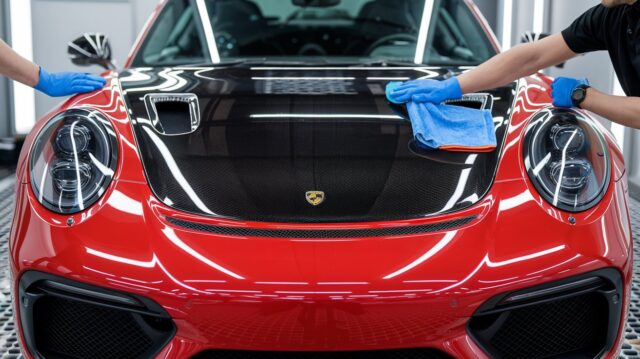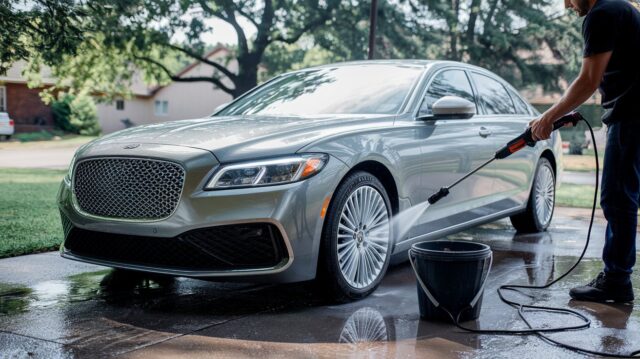How to Prepare Your Car for Ceramic Coating: A Step-by-Step Guide for a Flawless Finish
Getting your car to shine and remain protected against daily wear and tear is a goal many car owners share. The challenge, however, lies in achieving this while ensuring the best possible finish that lasts.
A popular solution is to apply advanced ceramic coating for vehicles yourself – a process known for its protective and aesthetic benefits. Yet, before you can enjoy these perks, knowing how to prepare your car for ceramic coating is crucial.
Prep work is key because it directly affects how well the ceramic coat bonds to your car’s paint surface. This article has a four-step process that will guide you through each step of preparing your vehicle for a ceramic coating application.
From gathering the right tools and products to ensuring a clean and smooth surface, we’ve got you covered with practical advice. Get ready to transform your car’s appearance!
What is the Best Way to Prep Your Car for Ceramic Coating?
Surface readiness is crucial before the application of a ceramic coating to your car paint correct it. This activity confirms that the nano-ceramic coating will bond well with the paint, offering lasting defense and sheen.
The process begins with a thorough car wash to erase any dirt, grime, or pollutants. Opt for a superior car shampoo crafted for preparation tasks to achieve the cleanest possible exterior.
After washing, a complete drying of your car’s wet vehicle is essential, as residual dampness could interfere with the coating’s bonding capability.
Preparation is pivotal to prolong the durability and efficiency of ceramic coatings.
Subsequently, it’s necessary to rid the car surface of impurities using a clay bar or a chemical contaminant remover. These products elevate and eliminate deeply seated pollutants in the car paint and remove contaminants that regular washing fails to remove.
With all the dirt and the car’s surface now particle-free, apply a polish, if needed, to correct any flaws such as swirl imprints or scratches. A smooth surface paves the way for a uniform application of the ceramic coating and enhances its look once cured.
Following these steps carefully gets your vehicle ready for a successful ceramic coating application that safeguards its exterior for the long run.
Why is Surface Prep Essential Before Applying Ceramic Coating?
Surface prep is vital before applying ceramic coating because it ensures that the coating bonds correctly to your car’s exterior. Any dirt, oil, or residue left on the vehicle can prevent the ceramic pro from bonding properly.
This bond is crucial for creating a durable layer of clear coat coating that protects against contaminants and gives your car a lasting shine. Proper surface preparation removes these barriers, allowing the nano ceramic coating to adhere seamlessly to your vehicle’s paint.
Starting the paint job with a clean surface also maximizes the effectiveness of the ceramic coating. It helps in ensuring that every part of your car’s exterior gets an even layer of protection.
Without thorough prep, areas missed during cleaning could lead to uneven application and reduced performance of the protective ceramic coatings. A well-prepared surface guarantees that the benefits of applying a ceramic coating, such as enhanced durability and improved appearance, are fully realized across the entire vehicle.

What Tools and Products Do You Need for Ceramic Coating Prep?
Understanding the importance of surface preparation prior to ceramic coating establishes the base for the essential subsequent phase. The right tools and products make sure your car’s surface is optimally prepared for applying a ceramic coating.
- High-quality car soap: Seek a potent, yet safe, formula to eliminate all dirt without causing damage to the paint.
- Microfiber towels: Employ these to dry your car thoroughly post-washing, as they excel in water absorption and minimize scratches.
- Clay bar: This instrument assists you in decontaminating the paint by eliminating embedded dirt particles that washing may not completely remove.
- Surface preparation spray: A reliable prep spray eradicates any residual matter left behind, ensuring nothing disrupts the coating’s bonding process.
- Polishing compound: Select a compound to polish out any lingering imperfections and establish a smooth base for the ceramic coating.
- Dual action polisher: This device applies the polishing compound uniformly, reducing manual effort and attaining superior results.
- Isopropyl alcohol (IPA) solution: After polishing, clean your car with an IPA solution to remove any remaining oils or compounds.
- Quality ceramic coating product: Choose a trusted ceramic coating that fits your car’s requirements and longevity expectations.
- Applicator pads: These are utilized to uniformly distribute the ceramic coating over your vehicle’s surface area without inflicting damage.
- Nitrile gloves: Shield your hands from chemicals present in cleaning agents and ensure no skin oils transfer to the car’s surface.
These tools and products build an effective foundation for preparing to apply a ceramic coating on your car’s exterior, leading to enduring protection and luster.
How to Properly Wash Your Car Before Ceramic Coating?
Ceramic coating for cars requires that your car is prepped well by washing it to ensure it has a clean exterior surface. This is very essential process through which the coating gets to adhere and offer the required shield on the body of the car. Here’s how you can get your car ready.
- Choose a shaded area to wash your car, preventing quick drying that can leave water spots.
- Gather all necessary supplies: a high-quality foamy car shampoo, two buckets (one for soap and one for rinsing), a microfiber wash mitt, and a soft drying towel.
- Fill one bucket with water and add enough car shampoo to create suds. Use the second bucket to rinse your mitt and keep it free from dirt.
- Rinse your car thoroughly with water to remove loose dirt and debris that could scratch the paint during washing.
- Start washing from the top of the car and work your way down, using the soapy water from the first bucket.
- Clean each section with gentle circular motions, frequently rinsing the mitt in the second bucket to avoid transferring dirt back onto your car.
- Pay special attention to hard-to-reach areas where grime accumulates, such as under door handles and around trim pieces.
- After washing every part of the exterior, rinse the vehicle completely with clean water, ensuring no soap residue remains.
- Using a soft microfiber towel, dry your vehicle thoroughly by blotting or gently dragging the towel over the surface.
Complete this prep process by inspecting your vehicle for any missed spots or remaining dirt particles that could interfere with applying the ceramic coating. Proper preparation ensures that your efforts result in a beautiful, long-lasting finish that protects your investment.
How to Ensure a Clean and Smooth Surface of Your Car?
Ensuring a clean and smooth exterior surface of your car begins with a thorough wash. You need to remove all dirt, grime, fine dust, and contaminants from the exterior of your car before applying the ceramic coating.
Use quality car wash soap to lift away dirt without damaging the clear coat. After washing, rinse the paint sealant car thoroughly to get rid of all soap residues.
Next comes decontamination. Apply a surface prep spray or use a clay bar over the entire car or vehicle to pull out any impurities left in the paint. This final step is crucial for prepping for ceramic coating because it ensures that nothing will prevent the coating from bonding properly.
Once your car owner decontaminated, you might find some imperfections on the paint. Use polish to remove these flaws and create an even smoother surface. These steps prepare a car for ceramic effectively, making sure that your vehicle’s exterior is optimal for applying ceramic coating.
What are the Steps to Decontaminate Your Car’s Surface?
Decontaminating your car’s surface prepares it for a ceramic coating, ensuring a clean and smooth finish. This step is vital because it removes all impurities that could prevent the coating from bonding properly. Here are the essential steps to decontaminate your car’s surface effectively:
- Wash the car thoroughly to remove loose dirt and grime. Start from the top and work your way down to ensure that you cover every inch.
- Apply a clay bar to pull out embedded contaminants from the paint. Glide the clay bar across the surface in a back-and-forth motion after applying lubricant.
- Use a chemical decontaminant to dissolve any iron particles clinging to your car’s paint. Spray it on, let it sit for a few minutes, then rinse off.
- Assess your vehicle for any tar or sap spots. If you find any, apply a solvent-based cleaner directly to these areas to break them down.
- Perform another wash with a pH-neutral soap to ensure that all chemicals used in previous steps are fully removed from the vehicle’s exterior.
- Dry the vehicle completely with microfiber towels or an air blower to prevent water spots and prepare it for polishing.
Following these steps will make sure that your car’s surface is perfectly prepped and ready for ceramic coating application, maximizing protection and shine.
How to Polish and Remove Imperfections from Your Car’s Paint?
Polishing your car’s paint is a crucial step in prepping for ceramic coating. It helps remove flaws like swirl marks and scratches, ensuring the coating adheres properly.
- Assemble all necessary tools and products for the task. These include a top-tier car polish, polishing pads, a dual-action polisher, and microfiber towels.
- Clean your car thoroughly to make sure the surface is free of dirt and debris. Utilize a decontamination car wash soap to break down any stubborn contaminants.
- Completely dry your vehicle using microfiber towels or a blower specifically made for car detailing to avoid water spots.
- Put a small quantity of car polish onto the polishing pad. Distribute it uniformly across the pad to prevent splatter and uneven application.
- Choose one part of your car to commence with, such as the hood or door panel. This targeted approach allows for comprehensive work in each area.
- Initiate the polisher at a low speed to disperse the polish over the section you’re working on before intensifying the speed for the actual polishing.
- Direct the polisher in overlapping motions across the surface—side to side, then up and down—to cover all areas evenly without missing spots.
- Continuously check your progress by wiping some polish with a clean microfiber towel to see if scratches and flaws are becoming less noticeable.
- Recurrence steps 4 through 8 for each section of your vehicle until you’ve polished every painted surface.
- After accomplishing all sections, use another clean microfiber towel to remove any remaining polish residue from your car’s surface.
It’s crucial that after polishing, you examine your vehicle under prime lighting conditions to make sure all flaws and light scratches have been removed before continuing with the ceramic coating installation.
Following this, we’ll explore why proper ceramic coating application is essential and how it reacts with your newly polished paint surface.
What is the Importance of Applying Ceramic Coating Correctly?
Applying a ceramic coating correctly is crucial because it ensures that the vehicle’s surface gets maximum protection. A well-applied coating bonds with the car’s paint job, creating a durable layer that shields against contaminants like dust, water, and UV rays.
This bonding process requires precision; if done incorrectly, the coating might not adhere properly to the car’s surface. That could leave the paint vulnerable to damage over time.
A ceramic coating acts as a strong barrier for your car’s exterior, but its effectiveness heavily relies on proper application.
The importance also lies in the longevity and aesthetics of your vehicle. A correctly applied ceramic coating will protect your car’s paintwork for years, maintaining its shine and reducing the need for frequent cleaning.
On the other hand, errors during the application can lead to issues such as streaks or uneven paint protection film, which compromise these benefits. Skipping steps in prep work or applying too much ceramic coating can prevent it from bonding correctly with your car’s paint.
How Does Ceramic Coating Bond to the Paint Surface?
Ceramic coating creates a strong bond with the car’s paint surface through a chemical reaction. Once applied, the liquid polymer in ceramic coatings links with the paint of your vehicle and forms a protective layer.
This process is crucial for ensuring that your car remains shielded from various contaminants and environmental damage.
The effectiveness of this bond depends on proper prep work on the surface of the car. A clean, contaminant-free surface allows for better adhesion, maximizing protection. This makes it essential to thoroughly prep for ceramic coating before applying this type of cutting compound of paint coating.
The result is a durable barrier that keeps your car looking new while offering long-term protection against elements like UV rays, rain, and dirt.
What are Common Mistakes to Avoid During the Coating Process?
Understanding how a ceramic coating bonds to the paint surface sets the stage for learning what not to do during the coating process. Avoiding common mistakes ensures that your car benefits from this protective layer for years to come.
- Skipping Surface Preparation: Proper ceramic coating prep work is crucial. Failing to remove all dirt and debris can prevent the coating from bonding properly.
- Applying in Direct Sunlight: The heat causes the coating to cure too quickly, leading to streaks and uneven coverage.
- Not Reading Instructions: Each ceramic coating kit has specific application guidelines. Ignoring these can result in poor adhesion and wasted effort.
- Using Too Much Product: Over-application does not improve effectiveness; it just makes buffing off excess more challenging and wastes product.
- Missing Spots During Application: Coverage should be even across all painted surfaces to ensure complete protection. Inconsistencies lead to vulnerable areas.
- Forgetting About Curing Time: Once applied, a ceramic coating needs time to cure fully. Exposure to elements too soon can ruin the coating.
- Waxing After Coating: Adding car wax on top of a ceramic coated car interferes with its hydrophobic properties, reducing effectiveness.
- Ignoring Maintenance Washes: Even after applying your ceramic coating, regular cleaning is essential to maintain its hydrophobic properties.
- Handling Immediately After Application: Touching or wiping the car before the coat has cured may introduce fingerprints or smudges, marring the finish.
Taking care of these points will help ensure that your vehicle’s ceramic coating adheres correctly and lasts as intended, giving your car that desired long-lasting shine and protection against contaminants.
Should You Hire a Ceramic Coating Professional or Do It Yourself?
Deciding between hiring a ceramic coating professional and taking the DIY route depends on several factors. A professional service ensures that your car benefits from expert application techniques, leading to a more durable and effective ceramic coat on.
Professionals have access to high-grade materials not always available in consumer kits. They also bring years of experience to the table, guaranteeing a flawless finish free of bubbles or missed spots.
A perfect ceramic coating requires precision, expertise, and the right tools.
On the other hand, DIY ceramic coating offers car owners the chance to personally handle their vehicle’s care at a potentially lower cost. With numerous tutorials and products on the market, enthusiastic owners can apply ceramic coatings themselves if they are willing to invest time in learning how to prepare their car surface properly.
However, achieving optimal results requires patience and attention to detail during prep work. Whether you decide to hire professionals or apply your ceramic yourself will ultimately hinge on weighing convenience against personal involvement and cost considerations.
What are the Benefits of Using a Professional Ceramic Coating Service?
Choosing a professional ceramic coating service ensures your car receives top-notch care. Specialists apply the coating accurately, leading to a perfect finish.
- Professional application assures consistent coating on your whole car, avoiding any overlooked areas or inconsistent layers that could weaken protection.
- Specialists utilize superior-quality products that are not typically accessible to the general consumer. These products guarantee that your car’s coating endures longer and safeguards better.
- Professionals know how to prepare your car surface correctly. They perform extra surface preparation steps like clay barring and polishing to make sure the ceramic coating bonds securely.
- A professional service often includes a warranty. If any problems occur with the ceramic coating, they will handle them at no additional cost.
- Hiring professionals conserves your time and energy. Applying a ceramic coating demands patience and skill, which might be challenging for someone without experience.
- Professionals can perform paint correction to eliminate flaws before applying the ceramic coating, ensuring a smoother finish.
- They provide maintenance suggestions personalized to your vehicle’s requirements, enabling your car to remain in pristine condition for a longer period after the ceramic coating has been applied.
The subsequent aspect to consider is whether DIY ceramic coating is a feasible option for car owners.
Is DIY Ceramic Coating a Viable Option for Car Owners?
Personally, I believe that applying a ceramic coating to your car is an enticing option for vehicle owners. It offers control over the procedure and might appear like a cost-friendly approach. Numerous car enthusiasts favour this direct involvement as it provides the opportunity to comprehend the preparation process for ceramic coating.
All you need is a high-standard bottle of ceramic, foundational tools, and spare time. Armed with comprehensive instructions, many people find that providing their car with a solid and shiny finish becomes a feasible objective.
Before taking on this project, though, I must comprehend that the application of a ceramic coating demands patience and a keen eye for detail. Errors during the application can hinder the coating’s bond, affecting its lifespan, everyday wear, and efficacy.
Hence, while DIY ceramic coating is certainly applicable for those desiring their cars to have high-grade protection without the need for a professional, success largely hinges on one’s readiness to adhere to the prep process precisely.
Subsequent topic: Keeping Up Your Car’s Ceramic Coating?
How to Maintain Your Car’s Ceramic Coating?
Maintaining your car’s ceramic coating ensures that the shine and protection last for years. Regular washing is crucial. Use a pH-neutral soap to clean water prevent the coating from bonding improperly.
Avoid harsh chemicals that can strip away the coating’s protective layers. After washing, drying your car with a microfiber towel helps keep the surface smooth and free of scratches.
To keep the ceramic coating in top condition, waxing your vehicle isn’t necessary, as it may interfere with its hydrophobic properties. Instead, consider applying a booster product specifically designed for ceramic-coated cars every few months.
This final step reinforces the coating’s durability and enhances its water-repelling effect. Always park your car under cover when possible to protect it from environmental damage and ensure that your investment in ceramic coating pays off by keeping your car looking new longer.

What are the recommended car care practices after Cooking?
After you apply the ceramic coating to your vehicle, proper care will ensure it lasts longer and stays vibrant. These practices help maintain the glossy look and protection of your coating.
- Wash your car regularly. Aim for at least every two weeks to prevent dirt and contaminants from bonding to the surface.
- Use a pH-neutral car shampoo. This type of shampoo will clean without damaging the ceramic coating’s integrity.
- Avoid automatic car washes. The harsh brushes can scratch and deteriorate the coating over time.
- Dry your vehicle with a microfiber towel after washing. Microfiber towels are soft and prevent swirl marks on your car’s surface.
- Apply a SiO2-infused sealant every few months. This reinforces the ceramic coating, adding an extra layer of protection.
- Keep your car out of direct sunlight when possible. Prolonged exposure can wear down the coating faster.
- Remove bird droppings and tree sap immediately. These substances can etch into the coating if left unattended.
- Waxing is not needed. Ceramic coatings provide more protection than standard wax so that additional waxing won’t be necessary.
- Inspect your coat periodically for any signs of wear or damage. Early detection makes repairs easier.
- Follow specific maintenance instructions provided by your ceramic pro installers or product guidelines.
Adhering to these recommended practices ensures that your car remains protected, making every ride enjoyable while keeping its aesthetics intact for years to come.
How Often Should You Clean Your Car Post-Ceramic Coating?
Cleaning your car after applying a ceramic coating is vital for maintaining its shine and protection. Experts recommend washing your vehicle every two weeks to keep the ceramic coating applied and in top condition.
This routine ensures that contaminants, which can damage the coating over time, are regularly removed. Using proper techniques and products during these washes maximizes the lifespan of your ceramic coating.
Frequent maintenance also helps you enjoy the benefits of a ceramic-coated car longer. It lets the coating perform its job—protecting your paint from UV rays, dirt, and water spots effectively.
Moving on to taking care of minor scratches becomes essential once you have established a regular cleaning schedule.
Conclusion
Prepping your car for ceramic coating turns it into a durable beauty on wheels. The steps we covered ensure that every inch of your vehicle shines and stays protected. With the right tools, washing, decontaminating, and polishing become straightforward tasks.
Whether you choose a pro or DIY, the outcome makes your car stand out. Let this guide inspire you to give your ride the care it deserves.






